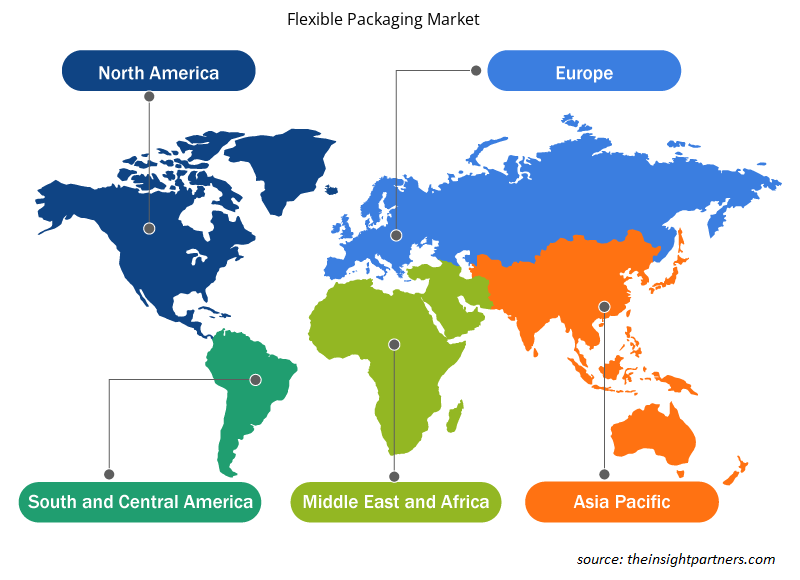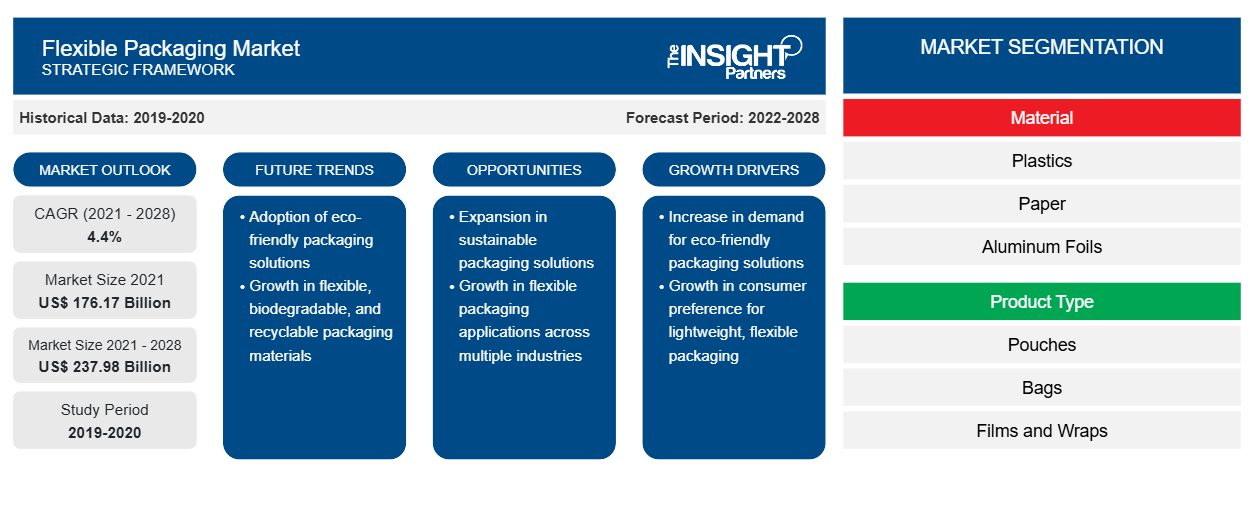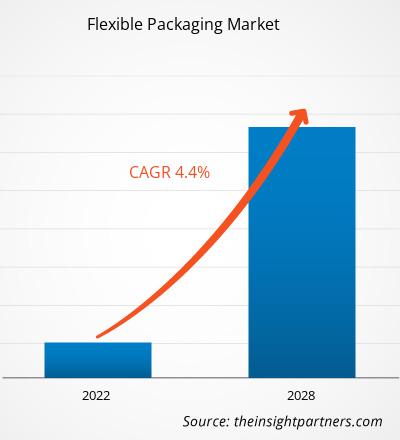من المتوقع أن يصل سوق التغليف المرن إلى 237،975.67 مليون دولار أمريكي بحلول عام 2028 من 176،173.61 مليون دولار أمريكي في عام 2021؛ ومن المتوقع أن ينمو بمعدل نمو سنوي مركب قدره 4.4٪ من عام 2021 إلى عام 2028.
تتضمن العبوات المرنة بطانات وأكياسًا وأختامًا وحزم عينات وأكياسًا. ويمكن أن تتكون من أغشية أو بلاستيك أو ورق أو رقائق معدنية وما إلى ذلك. وتُستخدم في العديد من المواد الغذائية والمشروبات والمنتجات الاستهلاكية وأقراص الموسيقى والأدوية وحزم برامج الكمبيوتر والمستحضرات الصيدلانية. وتتيح المتانة التي توفرها العبوات المرنة للمصنعين طباعة تصميمات مخصصة جذابة وعالية الجودة، مما يزيد من وضوح المنتج في بيئة البيع بالتجزئة.
في عام 2020، استحوذت منطقة آسيا والمحيط الهادئ على أكبر حصة من الإيرادات في سوق التغليف المرن العالمي . ووفقًا للتعاون الاقتصادي لآسيا والمحيط الهادئ، تعد أستراليا واحدة من الدول المتقدمة في منطقة آسيا والمحيط الهادئ. يعد قطاع الأغذية والمشروبات أكبر صناعة تصنيع في أستراليا، حيث يمثل 32٪ من إجمالي مبيعات التصنيع في البلاد. وفقًا لتقرير حالة الصناعة لعام 2019 الصادر عن مجلس الأغذية والبقالة الأسترالي، تبلغ قيمة قطاع الأغذية والمشروبات والبقالة والمنتجات الطازجة 85.32 مليار دولار أمريكي. تتكون الصناعة من 15000 شركة من جميع الأحجام توظف أكثر من 273000 شخص. تقود صناعة الأغذية والمشروبات المتنامية سوق التغليف المرن.
قم بتخصيص هذا التقرير ليناسب متطلباتك
ستحصل على تخصيص لأي تقرير - مجانًا - بما في ذلك أجزاء من هذا التقرير، أو تحليل على مستوى الدولة، وحزمة بيانات Excel، بالإضافة إلى الاستفادة من العروض والخصومات الرائعة للشركات الناشئة والجامعات
- احصل على أهم اتجاهات السوق الرئيسية لهذا التقرير.ستتضمن هذه العينة المجانية تحليلاً للبيانات، بدءًا من اتجاهات السوق وحتى التقديرات والتوقعات.
تأثير جائحة كوفيد-19 على سوق التغليف المرن
كان لإغلاق وحدات التصنيع، وصعوبة الحصول على المواد الخام، والقيود المفروضة على الخدمات اللوجستية تأثير سلبي على سوق التغليف المرن. ومع ذلك، خلقت جائحة كوفيد-19 ارتفاعات هائلة في توصيل البقالة عبر الإنترنت. بالإضافة إلى ذلك، تشهد صناعات الأغذية والمشروبات المعبأة ارتفاعًا في الطلب على الأطعمة والمشروبات المستقرة على الرفوف، بما في ذلك منتجات الألبان، حيث يسارع المستهلكون إلى تخزين المخازن. بدأت ملايين الأسر في شراء البقالة عبر الإنترنت للاستلام أو التوصيل إلى المنازل، وسيستمر العديد منها في استخدام خيارات التجارة الإلكترونية بعد مرور الأزمة. علاوة على ذلك، فإن الطلب المتزايد على المنتجات الغذائية المصنعة مثل الأطعمة الموجهة نحو الراحة والتي تستخدم عمومًا مواد تغليف عالية الجودة وعالية الحواجز من أجل عمر تخزين أطول من شأنه أن يشجع الحاجة إلى التغليف المرن.
رؤى السوق
زيادة استهلاك الأغذية والمشروبات المصنعة
وفقًا لتقرير Anu Food Brazil، بلغ إجمالي إيرادات قطاع تجارة التجزئة الغذائية البرازيلي 96 مليار دولار أمريكي في عام 2019. حققت صناعة الأغذية والمشروبات في البرازيل نموًا بنسبة 6.7٪ في عام 2019 و12.8٪ في عام 2020. تزدهر سوق الأغذية المجمدة في البرازيل. تزدهر سوق الأغذية المجمدة في البرازيل بسبب توسع الطبقة المتوسطة وارتفاع القوة الشرائية وزيادة عدد الأشخاص الذين يعملون بدوام كامل. وبالتالي، فإن تفضيل المستهلك المتزايد للأطعمة الجاهزة يحرك سوق التغليف المرن.Anu Food Brazil report, the Brazilian food retail sector’s total revenue was US$ 96 billion in 2019. The food & beverage industry in Brazil achieved growth of 6.7% in 2019 and 12.8% in 2020. The
رؤى حول صناعة المواد
بناءً على المواد، يتم تقسيم سوق التغليف المرن العالمي إلى البلاستيك والورق ورقائق الألومنيوم وغيرها. احتل قطاع البلاستيك الحصة الأكبر من سوق التغليف المرن العالمي في عام 2020. يتضمن التغليف البلاستيكي المرن أنواعًا مختلفة من المواد البلاستيكية المستخدمة في تغليف المنتجات المختلفة. يعتمد نوع المادة المستخدمة في التغليف على التطبيق ونوع المنتج المراد تعبئته. بشكل عام، تُستخدم المواد البلاستيكية، مثل البولي إيثيلين والبولي بروبيلين والبوليسترين وكلوريد البولي فينيل، في التغليف البلاستيكي المرن. يُعتبر التغليف المرن الطريقة الأكثر ملاءمة واقتصادًا لحفظ وتوزيع وتعبئة المواد الغذائية والمشروبات والمنتجات الصيدلانية والعديد من المواد الاستهلاكية.
تشمل بعض اللاعبين الرئيسيين العاملين في سوق التغليف المرن العالمي Amcor plc و Huhtamaki و Mondi و Berry Global Inc. و Sealed Air و Sonoco Products Company و Coveris و Constantia Flexibles و Flexpak services و Transcontinental Inc. يركز اللاعبون العاملون في السوق بشكل كبير على تطوير عروض المنتجات عالية الجودة والمبتكرة لتلبية متطلبات العملاء.
رؤى إقليمية حول سوق التغليف المرن
لقد قام المحللون في Insight Partners بشرح الاتجاهات والعوامل الإقليمية المؤثرة على سوق التغليف المرن طوال فترة التوقعات بشكل شامل. يناقش هذا القسم أيضًا قطاعات سوق التغليف المرن والجغرافيا في جميع أنحاء أمريكا الشمالية وأوروبا ومنطقة آسيا والمحيط الهادئ والشرق الأوسط وأفريقيا وأمريكا الجنوبية والوسطى.

- احصل على البيانات الإقليمية المحددة لسوق التغليف المرن
نطاق تقرير سوق التغليف المرن
| سمة التقرير | تفاصيل |
|---|---|
| حجم السوق في عام 2021 | 176.17 مليار دولار أمريكي |
| حجم السوق بحلول عام 2028 | 237.98 مليار دولار أمريكي |
| معدل النمو السنوي المركب العالمي (2021 - 2028) | 4.4% |
| البيانات التاريخية | 2019-2020 |
| فترة التنبؤ | 2022-2028 |
| القطاعات المغطاة | حسب المادة
|
| المناطق والدول المغطاة | أمريكا الشمالية
|
| قادة السوق وملفات تعريف الشركات الرئيسية |
|
كثافة اللاعبين في سوق التغليف المرن: فهم تأثيرها على ديناميكيات الأعمال
يشهد سوق التغليف المرن نموًا سريعًا، مدفوعًا بالطلب المتزايد من المستخدم النهائي بسبب عوامل مثل تفضيلات المستهلكين المتطورة والتقدم التكنولوجي والوعي المتزايد بفوائد المنتج. ومع ارتفاع الطلب، تعمل الشركات على توسيع عروضها والابتكار لتلبية احتياجات المستهلكين والاستفادة من الاتجاهات الناشئة، مما يؤدي إلى زيادة نمو السوق.
تشير كثافة اللاعبين في السوق إلى توزيع الشركات أو المؤسسات العاملة في سوق أو صناعة معينة. وهي تشير إلى عدد المنافسين (اللاعبين في السوق) الموجودين في مساحة سوق معينة نسبة إلى حجمها أو قيمتها السوقية الإجمالية.
الشركات الرئيسية العاملة في سوق التغليف المرن هي:
- شركة أمكور المحدودة
- هوتاماكي
- موندي
- شركة بيري العالمية
- هواء مختوم
إخلاء المسؤولية : الشركات المذكورة أعلاه ليست مرتبة بأي ترتيب معين.

- احصل على نظرة عامة على أهم اللاعبين الرئيسيين في سوق التغليف المرن
تقرير يسلط الضوء على
- الاتجاهات التقدمية في صناعة التغليف المرن لمساعدة اللاعبين على تطوير استراتيجيات فعالة طويلة الأجل
- استراتيجيات نمو الأعمال التي يتبناها اللاعبون في السوق في البلدان المتقدمة والنامية
- التحليل الكمي لسوق التغليف المرن من 2019 إلى 2028
- تقدير الطلب العالمي على التغليف المرن
- تحليل القوى الخمس لبورتر لتوضيح فعالية المشترين والموردين العاملين في الصناعة
- التطورات الأخيرة لفهم سيناريو السوق التنافسي
- اتجاهات السوق وتوقعاتها بالإضافة إلى العوامل التي تدفع وتكبح نمو سوق التغليف المرن
- المساعدة في عملية اتخاذ القرار من خلال تسليط الضوء على استراتيجيات السوق التي تدعم المصلحة التجارية، مما يؤدي إلى نمو السوق
- حجم سوق التغليف المرن في مختلف العقد
- نظرة عامة مفصلة وتقسيم السوق، بالإضافة إلى ديناميكيات الصناعة
- حجم سوق التغليف المرن في مختلف المناطق مع فرص نمو واعدة
- التحليل التاريخي (سنتان)، السنة الأساسية، التوقعات (7 سنوات) مع معدل النمو السنوي المركب
- تحليل PEST و SWOT
- حجم السوق والقيمة / الحجم - عالميًا وإقليميًا وقطريًا
- الصناعة والمنافسة
- مجموعة بيانات Excel



Report Coverage
Revenue forecast, Company Analysis, Industry landscape, Growth factors, and Trends

Segment Covered
This text is related
to segments covered.

Regional Scope
North America, Europe, Asia Pacific, Middle East & Africa, South & Central America

Country Scope
This text is related
to country scope.
الأسئلة الشائعة
The major players operating in the global flexible packaging market are Amcor plc; Huhtamaki; Mondi; Berry Global Inc.; Sealed Air; Sonoco Products Company; Coveris; Constantia Flexibles; Flexpak services; Transcontinental Inc.
In 2020, Asia-Pacific accounted for the largest share of the global flexible packaging market. The market for flexible packaging across Asia-Pacific has witnessed notable growth owing to the rapidly expanding packaging industry, growth of the food retail sector, and rising consumer awareness about sustainable packaging solutions across the region. The foodservice sector in Asia-Pacific is rapidly expanding owing to rapid economic growth, growth of the tourism sector, improving lifestyles of consumers, and rising disposable income levels. The region's food & beverage market is witnessing significant growth due to ample availability of various varieties of functional food and drinks and their growing demand among the millennial population. According to The Annual Report on Catering Industry Development of China 2019 (ARCIDC), China is the second-largest food and beverage economy across the world. The food and beverage revenue in China was over US$ 620 billion in 2018. The report further states that the online sales of food and beverages increased by US$ 44 billion from 2011 to 2017. Hence the growing demand for food & beverage in the region drives the flexible packaging market.
In 2020, the plastics segment accounted for the largest market share. Flexible plastic packaging delivers a wide range of protective properties while ensuring a minimum amount of material being used. It is made from high-grade polymers such as PVC, polyamide, polypropylene, and polyethylene. These polymers are FDA-approved and are contaminant-free. They can take on extreme temperatures and pressures. Furthermore, they also act as a protective layer for the food and beverage by protecting it from micro-organisms, UV rays, moisture, and dust.
The bags segment held the largest share of the market in 2020. These are commonly made of metal foil, plastic, and occasionally, paper. These bags are used in various packaging applications including food products, confectionery products, biscuits, coffee, powdered milk, snacks, etc. Also, these bags are easy for transport, material savings, and repeated use.
In 2020, Asia-Pacific is the fastest-growing region in the global flexible packaging market. According to Asia-Pacific Economic Cooperation, Australia is one of the developed countries in APAC. The food & beverage sector is Australia’s largest manufacturing industry, accounting for 32% of the country’s total manufacturing turnover. According to the Australian Food and Grocery Council’s 2019 State of the Industry Report, the food & beverage, grocery, and fresh produce sector is worth $122 billion. The industry is made up of 15,000 businesses of all sizes that employ over 273,000 people. The growing food & beverage industry drives the flexible packaging market.
The food and beverages segment held the largest share of the market in 2020. Flexible packaging is widely used for packaging food products such as eggs, fresh fruits and vegetables, and salad, among others. Flexible packaging protects products from moisture, UV rays, mold, dust, and other environmental contaminants that can negatively affect the product, thereby maintaining its quality and extending its shelf life. Also, with the growth of online food delivery channels the demand for flexible, affordable, and recyclable packaging is also on a rise.
The List of Companies - Flexible Packaging Market
- Amcor plc
- Huhtamaki
- Mondi
- Berry Global Inc.
- Sealed Air
- Sonoco Products Company
- Coveris
- Constantia Flexibles
- Flexpak services
- Transcontinental Inc.
The Insight Partners performs research in 4 major stages: Data Collection & Secondary Research, Primary Research, Data Analysis and Data Triangulation & Final Review.
- Data Collection and Secondary Research:
As a market research and consulting firm operating from a decade, we have published and advised several client across the globe. First step for any study will start with an assessment of currently available data and insights from existing reports. Further, historical and current market information is collected from Investor Presentations, Annual Reports, SEC Filings, etc., and other information related to company’s performance and market positioning are gathered from Paid Databases (Factiva, Hoovers, and Reuters) and various other publications available in public domain.
Several associations trade associates, technical forums, institutes, societies and organization are accessed to gain technical as well as market related insights through their publications such as research papers, blogs and press releases related to the studies are referred to get cues about the market. Further, white papers, journals, magazines, and other news articles published in last 3 years are scrutinized and analyzed to understand the current market trends.
- Primary Research:
The primarily interview analysis comprise of data obtained from industry participants interview and answers to survey questions gathered by in-house primary team.
For primary research, interviews are conducted with industry experts/CEOs/Marketing Managers/VPs/Subject Matter Experts from both demand and supply side to get a 360-degree view of the market. The primary team conducts several interviews based on the complexity of the markets to understand the various market trends and dynamics which makes research more credible and precise.
A typical research interview fulfils the following functions:
- Provides first-hand information on the market size, market trends, growth trends, competitive landscape, and outlook
- Validates and strengthens in-house secondary research findings
- Develops the analysis team’s expertise and market understanding
Primary research involves email interactions and telephone interviews for each market, category, segment, and sub-segment across geographies. The participants who typically take part in such a process include, but are not limited to:
- Industry participants: VPs, business development managers, market intelligence managers and national sales managers
- Outside experts: Valuation experts, research analysts and key opinion leaders specializing in the electronics and semiconductor industry.
Below is the breakup of our primary respondents by company, designation, and region:

Once we receive the confirmation from primary research sources or primary respondents, we finalize the base year market estimation and forecast the data as per the macroeconomic and microeconomic factors assessed during data collection.
- Data Analysis:
Once data is validated through both secondary as well as primary respondents, we finalize the market estimations by hypothesis formulation and factor analysis at regional and country level.
- Macro-Economic Factor Analysis:
We analyse macroeconomic indicators such the gross domestic product (GDP), increase in the demand for goods and services across industries, technological advancement, regional economic growth, governmental policies, the influence of COVID-19, PEST analysis, and other aspects. This analysis aids in setting benchmarks for various nations/regions and approximating market splits. Additionally, the general trend of the aforementioned components aid in determining the market's development possibilities.
- Country Level Data:
Various factors that are especially aligned to the country are taken into account to determine the market size for a certain area and country, including the presence of vendors, such as headquarters and offices, the country's GDP, demand patterns, and industry growth. To comprehend the market dynamics for the nation, a number of growth variables, inhibitors, application areas, and current market trends are researched. The aforementioned elements aid in determining the country's overall market's growth potential.
- Company Profile:
The “Table of Contents” is formulated by listing and analyzing more than 25 - 30 companies operating in the market ecosystem across geographies. However, we profile only 10 companies as a standard practice in our syndicate reports. These 10 companies comprise leading, emerging, and regional players. Nonetheless, our analysis is not restricted to the 10 listed companies, we also analyze other companies present in the market to develop a holistic view and understand the prevailing trends. The “Company Profiles” section in the report covers key facts, business description, products & services, financial information, SWOT analysis, and key developments. The financial information presented is extracted from the annual reports and official documents of the publicly listed companies. Upon collecting the information for the sections of respective companies, we verify them via various primary sources and then compile the data in respective company profiles. The company level information helps us in deriving the base number as well as in forecasting the market size.
- Developing Base Number:
Aggregation of sales statistics (2020-2022) and macro-economic factor, and other secondary and primary research insights are utilized to arrive at base number and related market shares for 2022. The data gaps are identified in this step and relevant market data is analyzed, collected from paid primary interviews or databases. On finalizing the base year market size, forecasts are developed on the basis of macro-economic, industry and market growth factors and company level analysis.
- Data Triangulation and Final Review:
The market findings and base year market size calculations are validated from supply as well as demand side. Demand side validations are based on macro-economic factor analysis and benchmarks for respective regions and countries. In case of supply side validations, revenues of major companies are estimated (in case not available) based on industry benchmark, approximate number of employees, product portfolio, and primary interviews revenues are gathered. Further revenue from target product/service segment is assessed to avoid overshooting of market statistics. In case of heavy deviations between supply and demand side values, all thes steps are repeated to achieve synchronization.
We follow an iterative model, wherein we share our research findings with Subject Matter Experts (SME’s) and Key Opinion Leaders (KOLs) until consensus view of the market is not formulated – this model negates any drastic deviation in the opinions of experts. Only validated and universally acceptable research findings are quoted in our reports.
We have important check points that we use to validate our research findings – which we call – data triangulation, where we validate the information, we generate from secondary sources with primary interviews and then we re-validate with our internal data bases and Subject matter experts. This comprehensive model enables us to deliver high quality, reliable data in shortest possible time.


 احصل على عينة مجانية لهذا التقرير
احصل على عينة مجانية لهذا التقرير